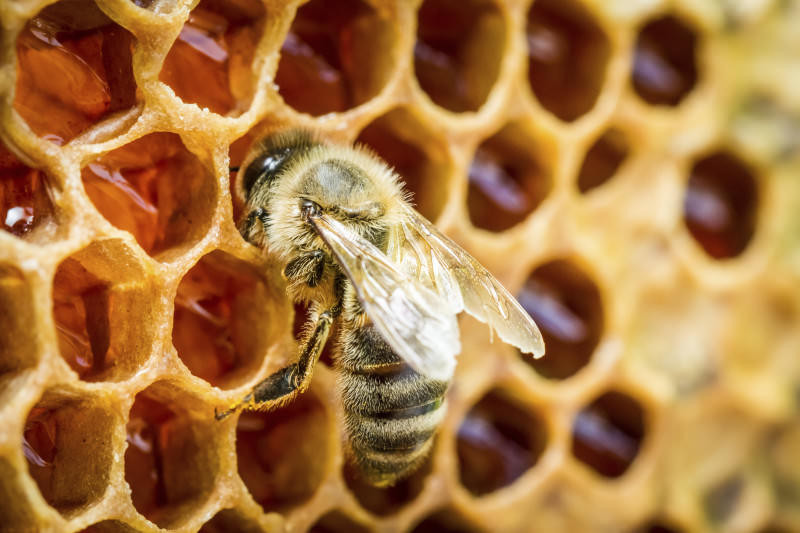
The Beginner’s Guide to Beekeeping
Posted by Grange Co-op on 29th Jan 2016
The process by which bees make honey is a fascinating natural wonder. Worker bees gather nectar and bring it to the hive. Hive bees continue breaking down the sugars before depositing it into a honeycomb cell. Hive bees use their wings to fan the transforming nectar to evaporate remaining water, thickening the nectar into honey. Finally, hive bees cap the beeswax cell to save the honey for eating later.
Hazel Thomas
When to start beekeeping
Spring, or more specifically March and April, is the beginning of bee season. “In spring, you need to have your hive and bees ready,” says Hazel, our beekeeping expert. “March and April are when bees come out of hibernation from winter and become active. They begin gathering their nectar and pollen and you will see bees everywhere, and the queen (Queen Excluder) will start laying eggs again.”
Use resources
 Before starting beekeeping, talk to local experts for advice. Southern Oregon Beekeeping Association is an excellent resource for asking questions and finding swarms of bees or nucs (nucleus colonies) to buy. Joining a club, you have an excellent resource for asking questions, buying supplies, finding swarms of bees, and ensuring your success.
Before starting beekeeping, talk to local experts for advice. Southern Oregon Beekeeping Association is an excellent resource for asking questions and finding swarms of bees or nucs (nucleus colonies) to buy. Joining a club, you have an excellent resource for asking questions, buying supplies, finding swarms of bees, and ensuring your success.
Other resources include beekeeping books and guides, including Keith Delaplane’s “First Lessons in Beekeeping” which introduces the basics of beekeeping, or Storey’s Guide To Keeping Honey Bees. There are also a lot of free beekeeping websites and forums, such as forum.beemaster.com and http://www.beesource.com/.
Is your home appropriate for keeping bees?
The first thing you need to know is whether you are allowed to keep bees on your property. Check your local municipality or county codes to find out if your zoning regulations allow you to maintain honeybee hives. If you live in a rural area, you should be just fine but you may have to register your location and pay a small fee.
We also suggest checking with neighbors to make sure they are comfortable with bees being close by. Usually the promise of a pot of honey does the trick.
Start with a hive
In nature, honey bees nest in natural cavities, tree hollows, between house joists, and a variety of other locations. By keeping your own bees, you will need to create a home, or habitat, for your honeybees called a “hive.”
The hive is a man made home for honey bees that includes a bottom board, hive bodies, frames that enclose honey combs, and covers. This is where the queen lives and where the bees return with nectar to create honey.
Hives come in a variety of styles, Langstroth hives being the most popular (we sell these at Grange Co-op in both 8 and 10 frame types).
Protective clothing/gear
Protective clothing helps prevent stings. While you don’t need a full beekeeping suit, you may feel more comfortable at first to ensure you are not stung. For most common beekeeping activities, beekeepers wear a hat and veil combination, and a lightweight jacket. For heavier duty beekeeping work, you may want to wear a full suit.
Choose a home for your bees
The location of your hive should be close to a food source for the bees, if possible. Bees consume nectar from flowers from gardens and fields. Food sources include white clover, asters, dandelions, maple trees, and citrus trees. Face the hive toward an open space and make sure the entrance has plenty of sunlight, which will help keep the hive warm during winter. The hive should also be close to a water source.
Supplies
In addition to your hive, you will need a smoker to calm the bees, a hive tool to loosen frames and boxes, and a bee brush.
You can also buy an entire hive complete, or buy individual items, like brood boxes, honey supers, a framehive and cover. Ask at your local Grange Co-op for advice as needed.
More Resources:
- Beekeeping: Getting Started (Video)
- Shop Grange Co-op for all your beekeeping supplies!
- The Many Benefits of Beekeeping!
- Collecting Honey Bees & Honey
- Backyard Beekeeping Main page

